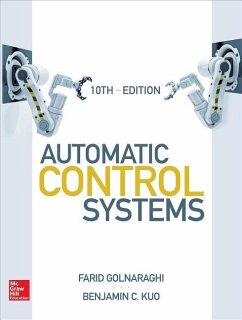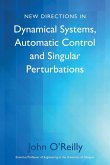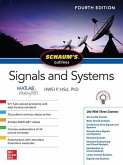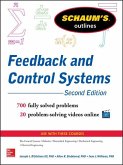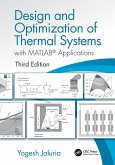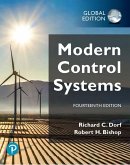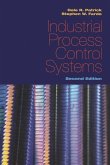- Gebundenes Buch
- Merkliste
- Auf die Merkliste
- Bewerten Bewerten
- Teilen
- Produkt teilen
- Produkterinnerung
- Produkterinnerung
Focuses on control systems. This edition delivers practical coverage designed to introduce readers to the essential concepts of automatic control systems without bogging them down with theoretical complexities. It also includes solved examples, labs using both LEGO Mindstorms[registered] and MATLAB/SIMLab.
Andere Kunden interessierten sich auch für
![New Directions in Dynamical Systems, Automatic Control and Singular Perturbations New Directions in Dynamical Systems, Automatic Control and Singular Perturbations]() John O'ReillyNew Directions in Dynamical Systems, Automatic Control and Singular Perturbations16,99 €
John O'ReillyNew Directions in Dynamical Systems, Automatic Control and Singular Perturbations16,99 €![Schaum's Outline of Signals and Systems, Fourth Edition Schaum's Outline of Signals and Systems, Fourth Edition]() Hwei HsuSchaum's Outline of Signals and Systems, Fourth Edition26,99 €
Hwei HsuSchaum's Outline of Signals and Systems, Fourth Edition26,99 €![Schaum's Outline of Feedback and Control Systems, Third Edition Schaum's Outline of Feedback and Control Systems, Third Edition]() Joseph DistefanoSchaum's Outline of Feedback and Control Systems, Third Edition35,99 €
Joseph DistefanoSchaum's Outline of Feedback and Control Systems, Third Edition35,99 €![Design and Optimization of Thermal Systems, Third Edition Design and Optimization of Thermal Systems, Third Edition]() Yogesh JaluriaDesign and Optimization of Thermal Systems, Third Edition122,99 €
Yogesh JaluriaDesign and Optimization of Thermal Systems, Third Edition122,99 €![Modern Control Systems, Global Edition Modern Control Systems, Global Edition]() Richard DorfModern Control Systems, Global Edition122,99 €
Richard DorfModern Control Systems, Global Edition122,99 €![Industrial Process Control Systems, Second Edition Industrial Process Control Systems, Second Edition]() Dale R. PatrickIndustrial Process Control Systems, Second Edition106,99 €
Dale R. PatrickIndustrial Process Control Systems, Second Edition106,99 €![Design of Fluid Thermal Systems, SI Edition Design of Fluid Thermal Systems, SI Edition]() William Janna (The University of Memphis)Design of Fluid Thermal Systems, SI Edition146,99 €
William Janna (The University of Memphis)Design of Fluid Thermal Systems, SI Edition146,99 €-
-
-
Focuses on control systems. This edition delivers practical coverage designed to introduce readers to the essential concepts of automatic control systems without bogging them down with theoretical complexities. It also includes solved examples, labs using both LEGO Mindstorms[registered] and MATLAB/SIMLab.
Hinweis: Dieser Artikel kann nur an eine deutsche Lieferadresse ausgeliefert werden.
Hinweis: Dieser Artikel kann nur an eine deutsche Lieferadresse ausgeliefert werden.
Produktdetails
- Produktdetails
- Verlag: McGraw-Hill Education
- 10 ed
- Seitenzahl: 866
- Erscheinungstermin: 21. Februar 2017
- Englisch
- Abmessung: 260mm x 208mm x 50mm
- Gewicht: 2068g
- ISBN-13: 9781259643835
- ISBN-10: 1259643832
- Artikelnr.: 45160863
- Herstellerkennzeichnung
- Libri GmbH
- Europaallee 1
- 36244 Bad Hersfeld
- gpsr@libri.de
- Verlag: McGraw-Hill Education
- 10 ed
- Seitenzahl: 866
- Erscheinungstermin: 21. Februar 2017
- Englisch
- Abmessung: 260mm x 208mm x 50mm
- Gewicht: 2068g
- ISBN-13: 9781259643835
- ISBN-10: 1259643832
- Artikelnr.: 45160863
- Herstellerkennzeichnung
- Libri GmbH
- Europaallee 1
- 36244 Bad Hersfeld
- gpsr@libri.de
Dr. Farid Golnaraghi has been a professor and the Director of Mechatronic Systems Engineering at the Simon Fraser University in Vancouver since 2006. He also holds a Burnaby Mountain Endowed Chair at SFU, and his primary research focuses on intelligent vehicle systems. Prior to joining SFU, Dr. Golnaraghi was a professor of Mechanical and Mechatronics Engineering at the University of Waterloo. His pioneering research has resulted in two textbooks, more than 150 journal and conference papers, four patents, and two start-up companies. Dr. Benjamin C. Kuo was a member of the faculty of the Department of Electrical and Computer Engineering at the University of Illinois, which he joined in 1958 upon the completion of his Ph.D. and where he remained for 31 rewarding years. He was a true visionary pioneer in the field of automatic control, and the impact of his distinguished career as a researcher and educator cannot be overstated.
Preface CHAPTER 1 Introduction to Control Systems 1-1 Basic Components of a Control System 1-2 Examples of Control-System Applications 1-2-1 Intelligent Transportation Systems 1-2-2 Steering Control of an Automobile 1-2-3 Idle-Speed Control of an Automobile 1-2-4 Sun-Tracking Control of Solar Collectors 1-3 Open-Loop Control Systems (Nonfeedback Systems) 1-4 Closed-Loop Control Systems (Feedback Control Systems) 1-5 What Is Feedback, and What Are Its Effects? 1-5-1 Effect of Feedback on Overall Gain 1-5-2 Effect of Feedback on Stability 1-5-3 Effect of Feedback on External Disturbance or Noise 1-6 Types of Feedback Control Systems 1-7 Linear versus Nonlinear Control Systems 1-8 Time-Invariant versus Time-Varying Systems 1-9 Continuous-Data Control Systems 1-10 Discrete-Data Control Systems 1-11 Case Study: Intelligent Vehicle Obstacle Avoidance-LEGO MINDSTORMS 1-12 Summary CHAPTER 2 Modeling of Dynamic Systems 2-1 Modeling of Simple Mechanical Systems 2-1-1 Translational Motion 2-1-2 Rotational Motion 2-1-3 Conversion between Translational and Rotational Motions 2-1-4 Gear Trains 2-1-5 Backlash and Dead Zone (Nonlinear Characteristics) 2-2 Introduction to Modeling of Simple Electrical Systems 2-2-1 Modeling of Passive Electrical Elements 2-2-2 Modeling of Electrical Networks 2-3 Introduction to Modeling of Thermal and Fluid Systems 2-3-1 Elementary Heat Transfer Properties 2-3-2 Elementary Fluid System Properties 2-4 Linearization of Nonlinear Systems 2-4-1 Linearization Using Taylor Series: Classical Representation 2-5 Analogies 2-6 Project: Introduction to LEGO MINDSTORMS NXT Motor-Mechanical Modeling 2-7 Summary References Problems CHAPTER 3 Solution of Differential Equations of Dynamic Systems 3-1 Introduction to Differential Equations 3-1-1 Linear Ordinary Differential Equations 3-1-2 Nonlinear Differential Equations 3-2 Laplace Transform 3-2-1 Definition of the Laplace Transform 3-2-2 Important Theorems of the Laplace Transform 3-2-3 Transfer Function 3-2-4 Characteristic Equation 3-2-5 Analytic Function 3-2-6 Poles of a Function 3-2-7 Zeros of a Function 3-2-8 Complex Conjugate Poles and Zeros 3-2-9 Final-Value Theorem 3-3 Inverse Laplace Transform by Partial-Fraction Expansion 3-3-1 Partial Fraction Expansion 3-4 Application of the Laplace Transform to the Solution of Linear Ordinary Differential Equations 3-4-1 First-Order Prototype System 3-4-2 Second-Order Prototype System 3-4-3 Second-Order Prototype System-Final Observations 3-5 Impulse Response and Transfer Functions of Linear Systems 3-5-1 Impulse Response 3-5-2 Time Response Using the Impulse Response 3-5-3 Transfer Function (Single-Input, Single-Output Systems) 3-6 Systems of First-Order Differential Equations: State Equations 3-6-1 Definition of State Variables 3-6-2 The Output Equation 3-7 Solution of the Linear Homogeneous State Equation 3-7-1 Transfer Functions (Multivariable Systems) 3-7-2 Characteristic Equation from State Equations 3-7-3 State Equations from the Transfer Function 3-8 Case Studies with MATLAB 3-9 Linearization Revisited-the State-Space Approach 3-10 Summary References Problems CHAPTER 4 Block Diagrams and Signal-Flow Graphs 4-1 Block Diagrams 4-1-1 Modeling of Typical Elements of Block Diagrams in Control Systems 4-1-2 Relation between Mathematical Equations and Block Diagrams 4-1-3 Block Diagram Reduction 4-1-4 Block Diagrams of Multi-Input Systems: Special Case-Systems with a Disturbance 4-1-5 Block Diagrams and Transfer Functions of Multivariable Systems 4-2 Signal-Flow Graphs 4-2-1 SFG Algebra 4-2-2 Definitions of SFG Terms 4-2-3 Gain Formula for SFG 4-2-4 Application of the Gain Formula between Output Nodes and Noninput Nodes 4-2-5 Simplified Gain Formula 4-3 State Diagram 4-3-1 From Differential Equations to State Diagrams 4-3-2 From State Diagrams to Transfer Functions 4-3-3 From State Diagrams to State and Output Equations 4-4 Case Studies 4-5 MATLAB Tools 4-6 Summary References Problems CHAPTER 5 Stability of Linear Control Systems 5-1 Introduction to Stability 5-2 Methods of Determining Stability 5-3 Routh-Hurwitz Criterion 5-3-1 Routh's Tabulation 5-3-2 Special Cases When Routh's Tabulation Terminates Prematurely 5-4 MATLAB Tools and Case Studies 5-5 Summary References Problems CHAPTER 6 Important Components of Feedback Control Systems 6-1 Modeling of Active Electrical Elements: Operational Amplifiers 6-1-1 The Ideal Op-Amp 6-1-2 Sums and Differences 6-1-3 First-Order Op-Amp Configurations 6-2 Sensors and Encoders in Control Systems 6-2-1 Potentiometer 6-2-2 Tachometers 6-2-3 Incremental Encoder 6-3 DC Motors in Control Systems 6-3-1 Basic Operational Principles of DC Motors 6-3-2 Basic Classifications of PM DC Motors 6-3-3 Surface-Wound DC Motors 6-3-4 Moving-Coil DC Motors 6-3-5 Brushless DC Motors 6-3-6 Mathematical Modeling of PM DC Motors 6-3-7 Relation between Ki and Kb 6-4 Speed and Position Control of a DC Motor 6-4-1 Speed Response and the Effects of Inductance and Disturbance: Open-Loop Response 6-4-2 Speed Control of DC Motors: Closed-Loop Response 6-4-3 Position Control 6-5 Case Studies: Practical Examples 6-6 The Control Lab: Introduction to LEGO MINDSTORMS NXT Motor-Modeling and Characterization 6-6-1 NXT Motor 6-6-2 Electrical Characteristics 6-6-3 Mechanical Characteristics 6-6-4 Speed Response and Model Verification 6-7 Summary References Problems CHAPTER 7 Time-Domain Performance of Control Systems 7-1 Time Response of Continuous-Data Systems: Introduction 7-2 Typical Test Signals to Evaluate Time-Response Performance of Control Systems 7-3 The Unit-Step Response and Time-Domain Specifications 7-4 Time Response of a Prototype First-Order System 7-5 Transient Response of a Prototype Second-Order System 7-5-1 Damping Ratio and Natural Frequency 7-5-2 Maximum Overshoot (0 <
< 1) 7-5-3 Delay Time and Rise Time (0 <
< 1) 7-5-4 Settling Time (5 and 2 Percent) 7-5-5 Transient Response Performance Criteria-Final Remarks 7-6 Steady-State Error 7-6-1 Definition of the Steady-State Error 7-6-2 Steady-State Error in Systems with a Disturbance 7-6-3 Types of Control Systems: Unity-Feedback Systems 7-6-4 Error Constants 7-6-5 Steady-State Error Caused by Nonlinear System Elements 7-7 Basic Control Systems and Effects of Adding Poles and Zeros to Transfer Functions 7-7-1 Addition of a Pole to the Forward-Path Transfer Function: Unity-Feedback Systems 7-7-2 Addition of a Pole to the Closed-Loop Transfer Function 7-7-3 Addition of a Zero to the Closed-Loop Transfer Function 7-7-4 Addition of a Zero to the Forward-Path Transfer Function: Unity-Feedback Systems 7-7-5 Addition of Poles and Zeros: Introduction to Control of Time Response 7-8 Dominant Poles and Zeros of Transfer Functions 7-8-1 Summary of Effects of Poles and Zeros 7-8-2 The Relative Damping Ratio 7-8-3 The Proper Way of Neglecting the Insignificant Poles with Consideration of the Steady-State Response 7-9 Case Study: Time-Domain Analysis of a Position-Control System 7-9-1 Unit-Step Transient Response 7-9-2 The Steady-State Response 7-9-3 Time Response of a Third-Order System-Electrical Time Constant Not Neglected 7-9-4 Unit-Step Transient Response 7-9-5 Steady-State Response 7-10 The Control Lab: Introduction to LEGO MINDSTORMS NXT Motor-Position Control 7-11 Summary References Problems CHAPTER 8 State-Space Analysis and Controller Design 8-1 State-Variable Analysis 8-2 Block Diagrams, Transfer Functions, and State Diagrams 8-2-1 Transfer Functions (Multivariable Systems) 8-2-2 Block Diagrams and Transfer Functions of Multivariable Systems 8-3 Systems of First-Order Differential Equations: State Equations 8-3-1 Definition of State Variables 8-3-2 The Output Equation 8-4 Vector-Matrix Representation of State Equations 8-5 State-Transition Matrix 8-5-1 Significance of the State-Transition Matrix 8-5-2 Properties of the State-Transition Matrix 8-6 State-Transition Equation 8-6-1 State-Transition Equation Determined from the State Diagram 8-7 Relationship between State Equations and High-Order Differential Equations 8-8 Relationship between State Equations and Transfer Functions 8-9 Characteristic Equations, Eigenvalues, and Eigenvectors 8-9-1 Characteristic Equation from a Differential Equation 8-9-2 Characteristic Equation from a Transfer Function 8-9-3 Characteristic Equation from State Equations 8-9-4 Eigenvalues 8-9-5 Eigenvectors 8-9-6 Generalized Eigenvectors 8-10 Similarity Transformation 8-10-1 Invariance Properties of the Similarity Transformations 8-10-2 Characteristic Equations, Eigenvalues, and Eigenvectors 8-10-3 Transfer-Function Matrix 8-10-4 Controllability Canonical Form 8-10-5 Observability Canonical Form 8-10-6 Diagonal Canonical Form 8-10-7 Jordan Canonical Form 8-11 Decompositions of Transfer F unctions 8-11-1 Direct Decomposition 8-11-2 Direct Decomposition to CCF 8-11-3 Direct Decomposition to OCF 8-11-4 Cascade Decomposition 8-11-5 Parallel Decomposition 8-12 Controllability of Control Systems 8-12-1 General Concept of Controllability 8-12-2 Definition of State Controllability 8-12-3 Alternate Tests on Controllability 8-13 Observability of Linear Systems 8-13-1 Definition of Observability 8-13-2 Alternate Tests on Observability 8-14 Relationship among Controllability, Observability, and Transfer Functions 8-15 Invariant Theorems on Controllability and Observability 8-16 Case Study: Magnetic-Ball Suspension System 8-16-1 The Characteristic Equation 8-17 State-Feedback Control 8-18 Pole-Placement Design through State Feedback 8-19 State Feedback with Integral Control 8-20 MATLAB Tools and Case Studies 8-20-1 Description and Use of the State-Space Analysis Tool 8-20-2 Description and Use of tfsym for State-Space Applications 8-21 Case Study: Position Control of the LEGO MINDSTORMS Robotic Arm System 8-22 Summary References Problems CHAPTER 9 Root-Locus Analysis 9-1 Basic Properties of the Root Loci 9-2 Properties of the Root Loci 9-2-1 K = 0 and K = ±8 Points 9-2-2 Number of Branches on the Root Loci 9-2-3 Symmetry of the RL 9-2-4 Angles of Asymptotes of the RL: Behavior of the RL at s = 8 9-2-5 Intersect of the Asymptotes (Centroid) 9-2-6 Root Loci on the Real Axis 9-2-7 Angles of Departure and Angles of Arrival of the RL 9-2-8 Intersection of the RL with the Imaginary Axis 9-2-9 Breakaway Points (Saddle Points) on the RL 9-2-10 Angles of Arrival and Departure of Root Loci at the Breakaway Point 9-2-11 Calculation of K on the Root Loci 9-2-12 Summary: Properties of the Root Loci 9-3 The Root Sensitivity 9-4 Design Aspects of the Root Loci 9-4-1 Effects of Adding Poles and Zeros to G(s)H(s) 9-4-2 Addition of Poles to G(s)H(s) 9-4-3 Addition of Zeros to G(s)H(s) 9-5 Root Contours: Multiple-Parameter Variation 9-6 MATLAB Tools 9-7 Summary References Problems CHAPTER 10 Frequency-Domain Analysis 10-1 Introduction to Frequency Response 10-1-1 Frequency Response of Closed-Loop Systems 10-1-2 Frequency-Domain Specifications 10-2 Mr,
r, and Bandwidth of the Prototype Second-Order System 10-2-1 Resonant Peak and Resonant Frequency 10-2-2 Bandwidth 10-3 Effects of Adding Poles and Zeros to the Forward-Path Transfer Function 10-3-1 Effects of Adding a Zero to the Forward-Path Transfer Function 10-3-2 Effects of Adding a Pole to the Forward-Path Transfer Function 10-4 Nyquist Stability Criterion: Fundamentals 10-4-1 Stability Problem 10-4-2 Definitions of Encircled and Enclosed 10-4-3 Number of Encirclements and Enclosures 10-4-4 Principles of the Argument 10-4-5 Nyquist Path 10-4-6 Nyquist Criterion and the L(s) or the G(s)H(s) Plot 10-5 Nyquist Criterion for Systems with Minimum-Phase Transfer Functions 10-5-1 Application of the Nyquist Criterion to Minimum-Phase Transfer Functions That Are Not Strictly Proper 10-6 Relation between the Root Loci and the Nyquist Plot 10-7 Illustrative Examples: Nyquist Criterion for Minimum-Phase Transfer Functions 10-8 Effects of Adding Poles and Zeros to L(s) on the Shape of the Nyquist Plot 10-8-1 Addition of Poles at s = 0 10-8-2 Addition of Finite Nonzero Poles 10-8-3 Addition of Zeros 10-9 Relative Stability: Gain Margin and Phase Margin 10-9-1 Gain Margin 10-9-2 Gain Margin of Nonminimum-Phase Systems 10-9-3 Phase Margin 10-10 Stability Analysis with the Bode Plot 10-10-1 Bode Plots of Systems with Pure Time Delays 10-11 Relative Stability Related to the Slope of the Magnitude Curve of the Bode Plot 10-11-1 Conditionally Stable System 10-12 Stability Analysis with the Magnitude-Phase Plot 10-13 Constant-M Loci in the Magnitude-Phase Plane: The Nichols Chart 10-14 Nichols Chart Applied to Nonunity-Feedback Systems 10-15 Sensitivity Studies in the Frequency Domain 10-16 MATLAB Tools and Case Studies 10-17 Summary References Problems CHAPTER 11 Design of Control Systems 11-1 Introduction 11-1-1 Design Specifications 11-1-2 Controller Configurations 11-1-3 Fundamental Principles of Design 11-2 Design with the PD Controller 11-2-1 Time-Domain Interpretation of PD Control 11-2-2 Frequency-Domain Interpretation of PD Control 11-2-3 Summary of Effects of PD Control 11-3 Design with the PI Controller 11-3-1 Time-Domain Interpretation and Design of PI Control 11-3-2 Frequency-Domain Interpretation and Design of PI Control 11-4 Design with the PID Controller 11-5 Design with Phase-Lead and Phase-Lag Controllers 11-5-1 Time-Domain Interpretation and Design of Phase-Lead Control 11-5-2 Frequency-Domain Interpretation and Design of Phase-Lead Control 11-5-3 Effects of Phase-Lead Compensation 11-5-4 Limitations of Single-Stage Phase-Lead Control 11-5-5 Multistage Phase-Lead Controller 11-5-6 Sensitivity Considerations 11-5-7 Time-Domain Interpretation and Design of Phase-Lag Control 11-5-8 Frequency-Domain Interpretation and Design of Phase-Lag Control 11-5-9 Effects and Limitations of Phase-Lag Control 11-5-10 Design with Lead-Lag Controller 11-6 Pole-Zero-Cancellation Design: Notch Filter 11-6-1 Second-Order Active Filter 11-6-2 Frequency-Domain Interpretation and Design 11-7 Forward and Feedforward Controllers 11-8 Design of Robust Control Systems 11-9 Minor-Loop Feedback Control 11-9-1 Rate-Feedback or Tachometer-Feedback Control 11-9-2 Minor-Loop Feedback Control with Active Filter 11-10 MATLAB Tools and Case Studies 11-11 The Control Lab References Problems INDEX
< 1) 7-5-3 Delay Time and Rise Time (0 <
< 1) 7-5-4 Settling Time (5 and 2 Percent) 7-5-5 Transient Response Performance Criteria-Final Remarks 7-6 Steady-State Error 7-6-1 Definition of the Steady-State Error 7-6-2 Steady-State Error in Systems with a Disturbance 7-6-3 Types of Control Systems: Unity-Feedback Systems 7-6-4 Error Constants 7-6-5 Steady-State Error Caused by Nonlinear System Elements 7-7 Basic Control Systems and Effects of Adding Poles and Zeros to Transfer Functions 7-7-1 Addition of a Pole to the Forward-Path Transfer Function: Unity-Feedback Systems 7-7-2 Addition of a Pole to the Closed-Loop Transfer Function 7-7-3 Addition of a Zero to the Closed-Loop Transfer Function 7-7-4 Addition of a Zero to the Forward-Path Transfer Function: Unity-Feedback Systems 7-7-5 Addition of Poles and Zeros: Introduction to Control of Time Response 7-8 Dominant Poles and Zeros of Transfer Functions 7-8-1 Summary of Effects of Poles and Zeros 7-8-2 The Relative Damping Ratio 7-8-3 The Proper Way of Neglecting the Insignificant Poles with Consideration of the Steady-State Response 7-9 Case Study: Time-Domain Analysis of a Position-Control System 7-9-1 Unit-Step Transient Response 7-9-2 The Steady-State Response 7-9-3 Time Response of a Third-Order System-Electrical Time Constant Not Neglected 7-9-4 Unit-Step Transient Response 7-9-5 Steady-State Response 7-10 The Control Lab: Introduction to LEGO MINDSTORMS NXT Motor-Position Control 7-11 Summary References Problems CHAPTER 8 State-Space Analysis and Controller Design 8-1 State-Variable Analysis 8-2 Block Diagrams, Transfer Functions, and State Diagrams 8-2-1 Transfer Functions (Multivariable Systems) 8-2-2 Block Diagrams and Transfer Functions of Multivariable Systems 8-3 Systems of First-Order Differential Equations: State Equations 8-3-1 Definition of State Variables 8-3-2 The Output Equation 8-4 Vector-Matrix Representation of State Equations 8-5 State-Transition Matrix 8-5-1 Significance of the State-Transition Matrix 8-5-2 Properties of the State-Transition Matrix 8-6 State-Transition Equation 8-6-1 State-Transition Equation Determined from the State Diagram 8-7 Relationship between State Equations and High-Order Differential Equations 8-8 Relationship between State Equations and Transfer Functions 8-9 Characteristic Equations, Eigenvalues, and Eigenvectors 8-9-1 Characteristic Equation from a Differential Equation 8-9-2 Characteristic Equation from a Transfer Function 8-9-3 Characteristic Equation from State Equations 8-9-4 Eigenvalues 8-9-5 Eigenvectors 8-9-6 Generalized Eigenvectors 8-10 Similarity Transformation 8-10-1 Invariance Properties of the Similarity Transformations 8-10-2 Characteristic Equations, Eigenvalues, and Eigenvectors 8-10-3 Transfer-Function Matrix 8-10-4 Controllability Canonical Form 8-10-5 Observability Canonical Form 8-10-6 Diagonal Canonical Form 8-10-7 Jordan Canonical Form 8-11 Decompositions of Transfer F unctions 8-11-1 Direct Decomposition 8-11-2 Direct Decomposition to CCF 8-11-3 Direct Decomposition to OCF 8-11-4 Cascade Decomposition 8-11-5 Parallel Decomposition 8-12 Controllability of Control Systems 8-12-1 General Concept of Controllability 8-12-2 Definition of State Controllability 8-12-3 Alternate Tests on Controllability 8-13 Observability of Linear Systems 8-13-1 Definition of Observability 8-13-2 Alternate Tests on Observability 8-14 Relationship among Controllability, Observability, and Transfer Functions 8-15 Invariant Theorems on Controllability and Observability 8-16 Case Study: Magnetic-Ball Suspension System 8-16-1 The Characteristic Equation 8-17 State-Feedback Control 8-18 Pole-Placement Design through State Feedback 8-19 State Feedback with Integral Control 8-20 MATLAB Tools and Case Studies 8-20-1 Description and Use of the State-Space Analysis Tool 8-20-2 Description and Use of tfsym for State-Space Applications 8-21 Case Study: Position Control of the LEGO MINDSTORMS Robotic Arm System 8-22 Summary References Problems CHAPTER 9 Root-Locus Analysis 9-1 Basic Properties of the Root Loci 9-2 Properties of the Root Loci 9-2-1 K = 0 and K = ±8 Points 9-2-2 Number of Branches on the Root Loci 9-2-3 Symmetry of the RL 9-2-4 Angles of Asymptotes of the RL: Behavior of the RL at s = 8 9-2-5 Intersect of the Asymptotes (Centroid) 9-2-6 Root Loci on the Real Axis 9-2-7 Angles of Departure and Angles of Arrival of the RL 9-2-8 Intersection of the RL with the Imaginary Axis 9-2-9 Breakaway Points (Saddle Points) on the RL 9-2-10 Angles of Arrival and Departure of Root Loci at the Breakaway Point 9-2-11 Calculation of K on the Root Loci 9-2-12 Summary: Properties of the Root Loci 9-3 The Root Sensitivity 9-4 Design Aspects of the Root Loci 9-4-1 Effects of Adding Poles and Zeros to G(s)H(s) 9-4-2 Addition of Poles to G(s)H(s) 9-4-3 Addition of Zeros to G(s)H(s) 9-5 Root Contours: Multiple-Parameter Variation 9-6 MATLAB Tools 9-7 Summary References Problems CHAPTER 10 Frequency-Domain Analysis 10-1 Introduction to Frequency Response 10-1-1 Frequency Response of Closed-Loop Systems 10-1-2 Frequency-Domain Specifications 10-2 Mr,
r, and Bandwidth of the Prototype Second-Order System 10-2-1 Resonant Peak and Resonant Frequency 10-2-2 Bandwidth 10-3 Effects of Adding Poles and Zeros to the Forward-Path Transfer Function 10-3-1 Effects of Adding a Zero to the Forward-Path Transfer Function 10-3-2 Effects of Adding a Pole to the Forward-Path Transfer Function 10-4 Nyquist Stability Criterion: Fundamentals 10-4-1 Stability Problem 10-4-2 Definitions of Encircled and Enclosed 10-4-3 Number of Encirclements and Enclosures 10-4-4 Principles of the Argument 10-4-5 Nyquist Path 10-4-6 Nyquist Criterion and the L(s) or the G(s)H(s) Plot 10-5 Nyquist Criterion for Systems with Minimum-Phase Transfer Functions 10-5-1 Application of the Nyquist Criterion to Minimum-Phase Transfer Functions That Are Not Strictly Proper 10-6 Relation between the Root Loci and the Nyquist Plot 10-7 Illustrative Examples: Nyquist Criterion for Minimum-Phase Transfer Functions 10-8 Effects of Adding Poles and Zeros to L(s) on the Shape of the Nyquist Plot 10-8-1 Addition of Poles at s = 0 10-8-2 Addition of Finite Nonzero Poles 10-8-3 Addition of Zeros 10-9 Relative Stability: Gain Margin and Phase Margin 10-9-1 Gain Margin 10-9-2 Gain Margin of Nonminimum-Phase Systems 10-9-3 Phase Margin 10-10 Stability Analysis with the Bode Plot 10-10-1 Bode Plots of Systems with Pure Time Delays 10-11 Relative Stability Related to the Slope of the Magnitude Curve of the Bode Plot 10-11-1 Conditionally Stable System 10-12 Stability Analysis with the Magnitude-Phase Plot 10-13 Constant-M Loci in the Magnitude-Phase Plane: The Nichols Chart 10-14 Nichols Chart Applied to Nonunity-Feedback Systems 10-15 Sensitivity Studies in the Frequency Domain 10-16 MATLAB Tools and Case Studies 10-17 Summary References Problems CHAPTER 11 Design of Control Systems 11-1 Introduction 11-1-1 Design Specifications 11-1-2 Controller Configurations 11-1-3 Fundamental Principles of Design 11-2 Design with the PD Controller 11-2-1 Time-Domain Interpretation of PD Control 11-2-2 Frequency-Domain Interpretation of PD Control 11-2-3 Summary of Effects of PD Control 11-3 Design with the PI Controller 11-3-1 Time-Domain Interpretation and Design of PI Control 11-3-2 Frequency-Domain Interpretation and Design of PI Control 11-4 Design with the PID Controller 11-5 Design with Phase-Lead and Phase-Lag Controllers 11-5-1 Time-Domain Interpretation and Design of Phase-Lead Control 11-5-2 Frequency-Domain Interpretation and Design of Phase-Lead Control 11-5-3 Effects of Phase-Lead Compensation 11-5-4 Limitations of Single-Stage Phase-Lead Control 11-5-5 Multistage Phase-Lead Controller 11-5-6 Sensitivity Considerations 11-5-7 Time-Domain Interpretation and Design of Phase-Lag Control 11-5-8 Frequency-Domain Interpretation and Design of Phase-Lag Control 11-5-9 Effects and Limitations of Phase-Lag Control 11-5-10 Design with Lead-Lag Controller 11-6 Pole-Zero-Cancellation Design: Notch Filter 11-6-1 Second-Order Active Filter 11-6-2 Frequency-Domain Interpretation and Design 11-7 Forward and Feedforward Controllers 11-8 Design of Robust Control Systems 11-9 Minor-Loop Feedback Control 11-9-1 Rate-Feedback or Tachometer-Feedback Control 11-9-2 Minor-Loop Feedback Control with Active Filter 11-10 MATLAB Tools and Case Studies 11-11 The Control Lab References Problems INDEX
Preface CHAPTER 1 Introduction to Control Systems 1-1 Basic Components of a Control System 1-2 Examples of Control-System Applications 1-2-1 Intelligent Transportation Systems 1-2-2 Steering Control of an Automobile 1-2-3 Idle-Speed Control of an Automobile 1-2-4 Sun-Tracking Control of Solar Collectors 1-3 Open-Loop Control Systems (Nonfeedback Systems) 1-4 Closed-Loop Control Systems (Feedback Control Systems) 1-5 What Is Feedback, and What Are Its Effects? 1-5-1 Effect of Feedback on Overall Gain 1-5-2 Effect of Feedback on Stability 1-5-3 Effect of Feedback on External Disturbance or Noise 1-6 Types of Feedback Control Systems 1-7 Linear versus Nonlinear Control Systems 1-8 Time-Invariant versus Time-Varying Systems 1-9 Continuous-Data Control Systems 1-10 Discrete-Data Control Systems 1-11 Case Study: Intelligent Vehicle Obstacle Avoidance-LEGO MINDSTORMS 1-12 Summary CHAPTER 2 Modeling of Dynamic Systems 2-1 Modeling of Simple Mechanical Systems 2-1-1 Translational Motion 2-1-2 Rotational Motion 2-1-3 Conversion between Translational and Rotational Motions 2-1-4 Gear Trains 2-1-5 Backlash and Dead Zone (Nonlinear Characteristics) 2-2 Introduction to Modeling of Simple Electrical Systems 2-2-1 Modeling of Passive Electrical Elements 2-2-2 Modeling of Electrical Networks 2-3 Introduction to Modeling of Thermal and Fluid Systems 2-3-1 Elementary Heat Transfer Properties 2-3-2 Elementary Fluid System Properties 2-4 Linearization of Nonlinear Systems 2-4-1 Linearization Using Taylor Series: Classical Representation 2-5 Analogies 2-6 Project: Introduction to LEGO MINDSTORMS NXT Motor-Mechanical Modeling 2-7 Summary References Problems CHAPTER 3 Solution of Differential Equations of Dynamic Systems 3-1 Introduction to Differential Equations 3-1-1 Linear Ordinary Differential Equations 3-1-2 Nonlinear Differential Equations 3-2 Laplace Transform 3-2-1 Definition of the Laplace Transform 3-2-2 Important Theorems of the Laplace Transform 3-2-3 Transfer Function 3-2-4 Characteristic Equation 3-2-5 Analytic Function 3-2-6 Poles of a Function 3-2-7 Zeros of a Function 3-2-8 Complex Conjugate Poles and Zeros 3-2-9 Final-Value Theorem 3-3 Inverse Laplace Transform by Partial-Fraction Expansion 3-3-1 Partial Fraction Expansion 3-4 Application of the Laplace Transform to the Solution of Linear Ordinary Differential Equations 3-4-1 First-Order Prototype System 3-4-2 Second-Order Prototype System 3-4-3 Second-Order Prototype System-Final Observations 3-5 Impulse Response and Transfer Functions of Linear Systems 3-5-1 Impulse Response 3-5-2 Time Response Using the Impulse Response 3-5-3 Transfer Function (Single-Input, Single-Output Systems) 3-6 Systems of First-Order Differential Equations: State Equations 3-6-1 Definition of State Variables 3-6-2 The Output Equation 3-7 Solution of the Linear Homogeneous State Equation 3-7-1 Transfer Functions (Multivariable Systems) 3-7-2 Characteristic Equation from State Equations 3-7-3 State Equations from the Transfer Function 3-8 Case Studies with MATLAB 3-9 Linearization Revisited-the State-Space Approach 3-10 Summary References Problems CHAPTER 4 Block Diagrams and Signal-Flow Graphs 4-1 Block Diagrams 4-1-1 Modeling of Typical Elements of Block Diagrams in Control Systems 4-1-2 Relation between Mathematical Equations and Block Diagrams 4-1-3 Block Diagram Reduction 4-1-4 Block Diagrams of Multi-Input Systems: Special Case-Systems with a Disturbance 4-1-5 Block Diagrams and Transfer Functions of Multivariable Systems 4-2 Signal-Flow Graphs 4-2-1 SFG Algebra 4-2-2 Definitions of SFG Terms 4-2-3 Gain Formula for SFG 4-2-4 Application of the Gain Formula between Output Nodes and Noninput Nodes 4-2-5 Simplified Gain Formula 4-3 State Diagram 4-3-1 From Differential Equations to State Diagrams 4-3-2 From State Diagrams to Transfer Functions 4-3-3 From State Diagrams to State and Output Equations 4-4 Case Studies 4-5 MATLAB Tools 4-6 Summary References Problems CHAPTER 5 Stability of Linear Control Systems 5-1 Introduction to Stability 5-2 Methods of Determining Stability 5-3 Routh-Hurwitz Criterion 5-3-1 Routh's Tabulation 5-3-2 Special Cases When Routh's Tabulation Terminates Prematurely 5-4 MATLAB Tools and Case Studies 5-5 Summary References Problems CHAPTER 6 Important Components of Feedback Control Systems 6-1 Modeling of Active Electrical Elements: Operational Amplifiers 6-1-1 The Ideal Op-Amp 6-1-2 Sums and Differences 6-1-3 First-Order Op-Amp Configurations 6-2 Sensors and Encoders in Control Systems 6-2-1 Potentiometer 6-2-2 Tachometers 6-2-3 Incremental Encoder 6-3 DC Motors in Control Systems 6-3-1 Basic Operational Principles of DC Motors 6-3-2 Basic Classifications of PM DC Motors 6-3-3 Surface-Wound DC Motors 6-3-4 Moving-Coil DC Motors 6-3-5 Brushless DC Motors 6-3-6 Mathematical Modeling of PM DC Motors 6-3-7 Relation between Ki and Kb 6-4 Speed and Position Control of a DC Motor 6-4-1 Speed Response and the Effects of Inductance and Disturbance: Open-Loop Response 6-4-2 Speed Control of DC Motors: Closed-Loop Response 6-4-3 Position Control 6-5 Case Studies: Practical Examples 6-6 The Control Lab: Introduction to LEGO MINDSTORMS NXT Motor-Modeling and Characterization 6-6-1 NXT Motor 6-6-2 Electrical Characteristics 6-6-3 Mechanical Characteristics 6-6-4 Speed Response and Model Verification 6-7 Summary References Problems CHAPTER 7 Time-Domain Performance of Control Systems 7-1 Time Response of Continuous-Data Systems: Introduction 7-2 Typical Test Signals to Evaluate Time-Response Performance of Control Systems 7-3 The Unit-Step Response and Time-Domain Specifications 7-4 Time Response of a Prototype First-Order System 7-5 Transient Response of a Prototype Second-Order System 7-5-1 Damping Ratio and Natural Frequency 7-5-2 Maximum Overshoot (0 <
< 1) 7-5-3 Delay Time and Rise Time (0 <
< 1) 7-5-4 Settling Time (5 and 2 Percent) 7-5-5 Transient Response Performance Criteria-Final Remarks 7-6 Steady-State Error 7-6-1 Definition of the Steady-State Error 7-6-2 Steady-State Error in Systems with a Disturbance 7-6-3 Types of Control Systems: Unity-Feedback Systems 7-6-4 Error Constants 7-6-5 Steady-State Error Caused by Nonlinear System Elements 7-7 Basic Control Systems and Effects of Adding Poles and Zeros to Transfer Functions 7-7-1 Addition of a Pole to the Forward-Path Transfer Function: Unity-Feedback Systems 7-7-2 Addition of a Pole to the Closed-Loop Transfer Function 7-7-3 Addition of a Zero to the Closed-Loop Transfer Function 7-7-4 Addition of a Zero to the Forward-Path Transfer Function: Unity-Feedback Systems 7-7-5 Addition of Poles and Zeros: Introduction to Control of Time Response 7-8 Dominant Poles and Zeros of Transfer Functions 7-8-1 Summary of Effects of Poles and Zeros 7-8-2 The Relative Damping Ratio 7-8-3 The Proper Way of Neglecting the Insignificant Poles with Consideration of the Steady-State Response 7-9 Case Study: Time-Domain Analysis of a Position-Control System 7-9-1 Unit-Step Transient Response 7-9-2 The Steady-State Response 7-9-3 Time Response of a Third-Order System-Electrical Time Constant Not Neglected 7-9-4 Unit-Step Transient Response 7-9-5 Steady-State Response 7-10 The Control Lab: Introduction to LEGO MINDSTORMS NXT Motor-Position Control 7-11 Summary References Problems CHAPTER 8 State-Space Analysis and Controller Design 8-1 State-Variable Analysis 8-2 Block Diagrams, Transfer Functions, and State Diagrams 8-2-1 Transfer Functions (Multivariable Systems) 8-2-2 Block Diagrams and Transfer Functions of Multivariable Systems 8-3 Systems of First-Order Differential Equations: State Equations 8-3-1 Definition of State Variables 8-3-2 The Output Equation 8-4 Vector-Matrix Representation of State Equations 8-5 State-Transition Matrix 8-5-1 Significance of the State-Transition Matrix 8-5-2 Properties of the State-Transition Matrix 8-6 State-Transition Equation 8-6-1 State-Transition Equation Determined from the State Diagram 8-7 Relationship between State Equations and High-Order Differential Equations 8-8 Relationship between State Equations and Transfer Functions 8-9 Characteristic Equations, Eigenvalues, and Eigenvectors 8-9-1 Characteristic Equation from a Differential Equation 8-9-2 Characteristic Equation from a Transfer Function 8-9-3 Characteristic Equation from State Equations 8-9-4 Eigenvalues 8-9-5 Eigenvectors 8-9-6 Generalized Eigenvectors 8-10 Similarity Transformation 8-10-1 Invariance Properties of the Similarity Transformations 8-10-2 Characteristic Equations, Eigenvalues, and Eigenvectors 8-10-3 Transfer-Function Matrix 8-10-4 Controllability Canonical Form 8-10-5 Observability Canonical Form 8-10-6 Diagonal Canonical Form 8-10-7 Jordan Canonical Form 8-11 Decompositions of Transfer F unctions 8-11-1 Direct Decomposition 8-11-2 Direct Decomposition to CCF 8-11-3 Direct Decomposition to OCF 8-11-4 Cascade Decomposition 8-11-5 Parallel Decomposition 8-12 Controllability of Control Systems 8-12-1 General Concept of Controllability 8-12-2 Definition of State Controllability 8-12-3 Alternate Tests on Controllability 8-13 Observability of Linear Systems 8-13-1 Definition of Observability 8-13-2 Alternate Tests on Observability 8-14 Relationship among Controllability, Observability, and Transfer Functions 8-15 Invariant Theorems on Controllability and Observability 8-16 Case Study: Magnetic-Ball Suspension System 8-16-1 The Characteristic Equation 8-17 State-Feedback Control 8-18 Pole-Placement Design through State Feedback 8-19 State Feedback with Integral Control 8-20 MATLAB Tools and Case Studies 8-20-1 Description and Use of the State-Space Analysis Tool 8-20-2 Description and Use of tfsym for State-Space Applications 8-21 Case Study: Position Control of the LEGO MINDSTORMS Robotic Arm System 8-22 Summary References Problems CHAPTER 9 Root-Locus Analysis 9-1 Basic Properties of the Root Loci 9-2 Properties of the Root Loci 9-2-1 K = 0 and K = ±8 Points 9-2-2 Number of Branches on the Root Loci 9-2-3 Symmetry of the RL 9-2-4 Angles of Asymptotes of the RL: Behavior of the RL at s = 8 9-2-5 Intersect of the Asymptotes (Centroid) 9-2-6 Root Loci on the Real Axis 9-2-7 Angles of Departure and Angles of Arrival of the RL 9-2-8 Intersection of the RL with the Imaginary Axis 9-2-9 Breakaway Points (Saddle Points) on the RL 9-2-10 Angles of Arrival and Departure of Root Loci at the Breakaway Point 9-2-11 Calculation of K on the Root Loci 9-2-12 Summary: Properties of the Root Loci 9-3 The Root Sensitivity 9-4 Design Aspects of the Root Loci 9-4-1 Effects of Adding Poles and Zeros to G(s)H(s) 9-4-2 Addition of Poles to G(s)H(s) 9-4-3 Addition of Zeros to G(s)H(s) 9-5 Root Contours: Multiple-Parameter Variation 9-6 MATLAB Tools 9-7 Summary References Problems CHAPTER 10 Frequency-Domain Analysis 10-1 Introduction to Frequency Response 10-1-1 Frequency Response of Closed-Loop Systems 10-1-2 Frequency-Domain Specifications 10-2 Mr,
r, and Bandwidth of the Prototype Second-Order System 10-2-1 Resonant Peak and Resonant Frequency 10-2-2 Bandwidth 10-3 Effects of Adding Poles and Zeros to the Forward-Path Transfer Function 10-3-1 Effects of Adding a Zero to the Forward-Path Transfer Function 10-3-2 Effects of Adding a Pole to the Forward-Path Transfer Function 10-4 Nyquist Stability Criterion: Fundamentals 10-4-1 Stability Problem 10-4-2 Definitions of Encircled and Enclosed 10-4-3 Number of Encirclements and Enclosures 10-4-4 Principles of the Argument 10-4-5 Nyquist Path 10-4-6 Nyquist Criterion and the L(s) or the G(s)H(s) Plot 10-5 Nyquist Criterion for Systems with Minimum-Phase Transfer Functions 10-5-1 Application of the Nyquist Criterion to Minimum-Phase Transfer Functions That Are Not Strictly Proper 10-6 Relation between the Root Loci and the Nyquist Plot 10-7 Illustrative Examples: Nyquist Criterion for Minimum-Phase Transfer Functions 10-8 Effects of Adding Poles and Zeros to L(s) on the Shape of the Nyquist Plot 10-8-1 Addition of Poles at s = 0 10-8-2 Addition of Finite Nonzero Poles 10-8-3 Addition of Zeros 10-9 Relative Stability: Gain Margin and Phase Margin 10-9-1 Gain Margin 10-9-2 Gain Margin of Nonminimum-Phase Systems 10-9-3 Phase Margin 10-10 Stability Analysis with the Bode Plot 10-10-1 Bode Plots of Systems with Pure Time Delays 10-11 Relative Stability Related to the Slope of the Magnitude Curve of the Bode Plot 10-11-1 Conditionally Stable System 10-12 Stability Analysis with the Magnitude-Phase Plot 10-13 Constant-M Loci in the Magnitude-Phase Plane: The Nichols Chart 10-14 Nichols Chart Applied to Nonunity-Feedback Systems 10-15 Sensitivity Studies in the Frequency Domain 10-16 MATLAB Tools and Case Studies 10-17 Summary References Problems CHAPTER 11 Design of Control Systems 11-1 Introduction 11-1-1 Design Specifications 11-1-2 Controller Configurations 11-1-3 Fundamental Principles of Design 11-2 Design with the PD Controller 11-2-1 Time-Domain Interpretation of PD Control 11-2-2 Frequency-Domain Interpretation of PD Control 11-2-3 Summary of Effects of PD Control 11-3 Design with the PI Controller 11-3-1 Time-Domain Interpretation and Design of PI Control 11-3-2 Frequency-Domain Interpretation and Design of PI Control 11-4 Design with the PID Controller 11-5 Design with Phase-Lead and Phase-Lag Controllers 11-5-1 Time-Domain Interpretation and Design of Phase-Lead Control 11-5-2 Frequency-Domain Interpretation and Design of Phase-Lead Control 11-5-3 Effects of Phase-Lead Compensation 11-5-4 Limitations of Single-Stage Phase-Lead Control 11-5-5 Multistage Phase-Lead Controller 11-5-6 Sensitivity Considerations 11-5-7 Time-Domain Interpretation and Design of Phase-Lag Control 11-5-8 Frequency-Domain Interpretation and Design of Phase-Lag Control 11-5-9 Effects and Limitations of Phase-Lag Control 11-5-10 Design with Lead-Lag Controller 11-6 Pole-Zero-Cancellation Design: Notch Filter 11-6-1 Second-Order Active Filter 11-6-2 Frequency-Domain Interpretation and Design 11-7 Forward and Feedforward Controllers 11-8 Design of Robust Control Systems 11-9 Minor-Loop Feedback Control 11-9-1 Rate-Feedback or Tachometer-Feedback Control 11-9-2 Minor-Loop Feedback Control with Active Filter 11-10 MATLAB Tools and Case Studies 11-11 The Control Lab References Problems INDEX
< 1) 7-5-3 Delay Time and Rise Time (0 <
< 1) 7-5-4 Settling Time (5 and 2 Percent) 7-5-5 Transient Response Performance Criteria-Final Remarks 7-6 Steady-State Error 7-6-1 Definition of the Steady-State Error 7-6-2 Steady-State Error in Systems with a Disturbance 7-6-3 Types of Control Systems: Unity-Feedback Systems 7-6-4 Error Constants 7-6-5 Steady-State Error Caused by Nonlinear System Elements 7-7 Basic Control Systems and Effects of Adding Poles and Zeros to Transfer Functions 7-7-1 Addition of a Pole to the Forward-Path Transfer Function: Unity-Feedback Systems 7-7-2 Addition of a Pole to the Closed-Loop Transfer Function 7-7-3 Addition of a Zero to the Closed-Loop Transfer Function 7-7-4 Addition of a Zero to the Forward-Path Transfer Function: Unity-Feedback Systems 7-7-5 Addition of Poles and Zeros: Introduction to Control of Time Response 7-8 Dominant Poles and Zeros of Transfer Functions 7-8-1 Summary of Effects of Poles and Zeros 7-8-2 The Relative Damping Ratio 7-8-3 The Proper Way of Neglecting the Insignificant Poles with Consideration of the Steady-State Response 7-9 Case Study: Time-Domain Analysis of a Position-Control System 7-9-1 Unit-Step Transient Response 7-9-2 The Steady-State Response 7-9-3 Time Response of a Third-Order System-Electrical Time Constant Not Neglected 7-9-4 Unit-Step Transient Response 7-9-5 Steady-State Response 7-10 The Control Lab: Introduction to LEGO MINDSTORMS NXT Motor-Position Control 7-11 Summary References Problems CHAPTER 8 State-Space Analysis and Controller Design 8-1 State-Variable Analysis 8-2 Block Diagrams, Transfer Functions, and State Diagrams 8-2-1 Transfer Functions (Multivariable Systems) 8-2-2 Block Diagrams and Transfer Functions of Multivariable Systems 8-3 Systems of First-Order Differential Equations: State Equations 8-3-1 Definition of State Variables 8-3-2 The Output Equation 8-4 Vector-Matrix Representation of State Equations 8-5 State-Transition Matrix 8-5-1 Significance of the State-Transition Matrix 8-5-2 Properties of the State-Transition Matrix 8-6 State-Transition Equation 8-6-1 State-Transition Equation Determined from the State Diagram 8-7 Relationship between State Equations and High-Order Differential Equations 8-8 Relationship between State Equations and Transfer Functions 8-9 Characteristic Equations, Eigenvalues, and Eigenvectors 8-9-1 Characteristic Equation from a Differential Equation 8-9-2 Characteristic Equation from a Transfer Function 8-9-3 Characteristic Equation from State Equations 8-9-4 Eigenvalues 8-9-5 Eigenvectors 8-9-6 Generalized Eigenvectors 8-10 Similarity Transformation 8-10-1 Invariance Properties of the Similarity Transformations 8-10-2 Characteristic Equations, Eigenvalues, and Eigenvectors 8-10-3 Transfer-Function Matrix 8-10-4 Controllability Canonical Form 8-10-5 Observability Canonical Form 8-10-6 Diagonal Canonical Form 8-10-7 Jordan Canonical Form 8-11 Decompositions of Transfer F unctions 8-11-1 Direct Decomposition 8-11-2 Direct Decomposition to CCF 8-11-3 Direct Decomposition to OCF 8-11-4 Cascade Decomposition 8-11-5 Parallel Decomposition 8-12 Controllability of Control Systems 8-12-1 General Concept of Controllability 8-12-2 Definition of State Controllability 8-12-3 Alternate Tests on Controllability 8-13 Observability of Linear Systems 8-13-1 Definition of Observability 8-13-2 Alternate Tests on Observability 8-14 Relationship among Controllability, Observability, and Transfer Functions 8-15 Invariant Theorems on Controllability and Observability 8-16 Case Study: Magnetic-Ball Suspension System 8-16-1 The Characteristic Equation 8-17 State-Feedback Control 8-18 Pole-Placement Design through State Feedback 8-19 State Feedback with Integral Control 8-20 MATLAB Tools and Case Studies 8-20-1 Description and Use of the State-Space Analysis Tool 8-20-2 Description and Use of tfsym for State-Space Applications 8-21 Case Study: Position Control of the LEGO MINDSTORMS Robotic Arm System 8-22 Summary References Problems CHAPTER 9 Root-Locus Analysis 9-1 Basic Properties of the Root Loci 9-2 Properties of the Root Loci 9-2-1 K = 0 and K = ±8 Points 9-2-2 Number of Branches on the Root Loci 9-2-3 Symmetry of the RL 9-2-4 Angles of Asymptotes of the RL: Behavior of the RL at s = 8 9-2-5 Intersect of the Asymptotes (Centroid) 9-2-6 Root Loci on the Real Axis 9-2-7 Angles of Departure and Angles of Arrival of the RL 9-2-8 Intersection of the RL with the Imaginary Axis 9-2-9 Breakaway Points (Saddle Points) on the RL 9-2-10 Angles of Arrival and Departure of Root Loci at the Breakaway Point 9-2-11 Calculation of K on the Root Loci 9-2-12 Summary: Properties of the Root Loci 9-3 The Root Sensitivity 9-4 Design Aspects of the Root Loci 9-4-1 Effects of Adding Poles and Zeros to G(s)H(s) 9-4-2 Addition of Poles to G(s)H(s) 9-4-3 Addition of Zeros to G(s)H(s) 9-5 Root Contours: Multiple-Parameter Variation 9-6 MATLAB Tools 9-7 Summary References Problems CHAPTER 10 Frequency-Domain Analysis 10-1 Introduction to Frequency Response 10-1-1 Frequency Response of Closed-Loop Systems 10-1-2 Frequency-Domain Specifications 10-2 Mr,
r, and Bandwidth of the Prototype Second-Order System 10-2-1 Resonant Peak and Resonant Frequency 10-2-2 Bandwidth 10-3 Effects of Adding Poles and Zeros to the Forward-Path Transfer Function 10-3-1 Effects of Adding a Zero to the Forward-Path Transfer Function 10-3-2 Effects of Adding a Pole to the Forward-Path Transfer Function 10-4 Nyquist Stability Criterion: Fundamentals 10-4-1 Stability Problem 10-4-2 Definitions of Encircled and Enclosed 10-4-3 Number of Encirclements and Enclosures 10-4-4 Principles of the Argument 10-4-5 Nyquist Path 10-4-6 Nyquist Criterion and the L(s) or the G(s)H(s) Plot 10-5 Nyquist Criterion for Systems with Minimum-Phase Transfer Functions 10-5-1 Application of the Nyquist Criterion to Minimum-Phase Transfer Functions That Are Not Strictly Proper 10-6 Relation between the Root Loci and the Nyquist Plot 10-7 Illustrative Examples: Nyquist Criterion for Minimum-Phase Transfer Functions 10-8 Effects of Adding Poles and Zeros to L(s) on the Shape of the Nyquist Plot 10-8-1 Addition of Poles at s = 0 10-8-2 Addition of Finite Nonzero Poles 10-8-3 Addition of Zeros 10-9 Relative Stability: Gain Margin and Phase Margin 10-9-1 Gain Margin 10-9-2 Gain Margin of Nonminimum-Phase Systems 10-9-3 Phase Margin 10-10 Stability Analysis with the Bode Plot 10-10-1 Bode Plots of Systems with Pure Time Delays 10-11 Relative Stability Related to the Slope of the Magnitude Curve of the Bode Plot 10-11-1 Conditionally Stable System 10-12 Stability Analysis with the Magnitude-Phase Plot 10-13 Constant-M Loci in the Magnitude-Phase Plane: The Nichols Chart 10-14 Nichols Chart Applied to Nonunity-Feedback Systems 10-15 Sensitivity Studies in the Frequency Domain 10-16 MATLAB Tools and Case Studies 10-17 Summary References Problems CHAPTER 11 Design of Control Systems 11-1 Introduction 11-1-1 Design Specifications 11-1-2 Controller Configurations 11-1-3 Fundamental Principles of Design 11-2 Design with the PD Controller 11-2-1 Time-Domain Interpretation of PD Control 11-2-2 Frequency-Domain Interpretation of PD Control 11-2-3 Summary of Effects of PD Control 11-3 Design with the PI Controller 11-3-1 Time-Domain Interpretation and Design of PI Control 11-3-2 Frequency-Domain Interpretation and Design of PI Control 11-4 Design with the PID Controller 11-5 Design with Phase-Lead and Phase-Lag Controllers 11-5-1 Time-Domain Interpretation and Design of Phase-Lead Control 11-5-2 Frequency-Domain Interpretation and Design of Phase-Lead Control 11-5-3 Effects of Phase-Lead Compensation 11-5-4 Limitations of Single-Stage Phase-Lead Control 11-5-5 Multistage Phase-Lead Controller 11-5-6 Sensitivity Considerations 11-5-7 Time-Domain Interpretation and Design of Phase-Lag Control 11-5-8 Frequency-Domain Interpretation and Design of Phase-Lag Control 11-5-9 Effects and Limitations of Phase-Lag Control 11-5-10 Design with Lead-Lag Controller 11-6 Pole-Zero-Cancellation Design: Notch Filter 11-6-1 Second-Order Active Filter 11-6-2 Frequency-Domain Interpretation and Design 11-7 Forward and Feedforward Controllers 11-8 Design of Robust Control Systems 11-9 Minor-Loop Feedback Control 11-9-1 Rate-Feedback or Tachometer-Feedback Control 11-9-2 Minor-Loop Feedback Control with Active Filter 11-10 MATLAB Tools and Case Studies 11-11 The Control Lab References Problems INDEX

